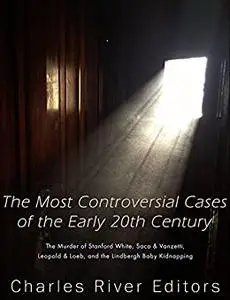The Most Controversial Cases of the Early 20th Century: The Murder of Stanford White, Sacco & Vanzetti, Leopold & Loeb, and the Lindbergh Baby Kidnapping by Charles River Editors
English | August 30, 2016 | ISBN: 1537335650 | 186 pages | EPUB | 4.76 Mb
English | August 30, 2016 | ISBN: 1537335650 | 186 pages | EPUB | 4.76 Mb
*Includes pictures *Includes accounts of the crimes and trials *Includes online resources and a bibliography for further reading It reads like a modern day Lifetime movie: two talented, popular and wealthy men both fall in love with the same beautiful but somewhat tarnished girl. One had a long history of mental illness, the other was considered an architectural genius. The inevitable showdown, complete with a very public murder, took place in one of the most fashionable restaurants in the world. Although it reads like a movie or soap opera, it was an all too true story that culminated with the 1907 “trial of the century,” when railroad tycoon Harry Thaw, the husband of famous model Evelyn Nesbit, was prosecuted for killing renowned architect Stanford White, his wife’s former lover. Some say that it was such a shocking event that it actually helped speed the end of the Gilded Age. There are few cases in American history as well known as Sacco and Vanzetti, and perhaps none of them were as controversial or socially charged as the trials against the two Italian immigrants in the early 20th century. The two avowed anarchists were ultimately tried and executed for murder and armed robbery, but the case said as much about the society trying them as it did about their guilt or innocence. Over 90 years later, there is still a heated debate over whether the two men, who arduously asserted their innocence, were actually guilty, but what is clear is that many Americans at the time believed they were being unjustly accused based on anti-Italian prejudice and disdain for their political beliefs. There has been no shortage of shocking crimes and trials that generated frenzied coverage across America, but few can lay claim to “crime of the century” like the murder carried out by Nathan Leopold and Richard Loeb in 1924. While studying as young adults at the prestigious University of Chicago, Leopold and Loeb devised a meticulous plot to kidnap and murder a child while managing to get away with ransom money, thereby perpetrating what they considered a “perfect crime.” The crime was horrific enough, but the trial brought even more attention to the case, and it touched on several crucial issues. Both young men cited the philosophy of Friedrich Nietzsche as a motivation for attempting to commit the crime and prove they were better than the common man. As Leopold told his own attorney, "The killing was an experiment It is just as easy to justify such a death as it is to justify an entomologist killing a beetle on a pin." Amelia Earhart once noted, "In my life I had come to realize that when things were going very well indeed it was just the time to anticipate trouble.” And so it would be with America’s other famous aviator. Charles Lindbergh had spent the first 30 years of his life escaping multiple plane crashes, becoming a hero across the world, and starting a family, but his luck ran out in an awful way in March of 1932. Tragically, the other major life event associated with Charles Lindbergh besides his historic transatlantic flight was “the crime of the century.” On March 1, 1932, 20 month old Charles, Jr. was kidnapped right out of his crib from the family’s home in rural East Amwell, New Jersey, and for 10 long weeks, the nation hoped and prayed in chorus with the distraught parents for his safe return. Through careful investigation, the police were able to arrest Bruno Richard Hauptmann for the crime about 30 months later, after they tracked some of the money paid through the ransom to a gas station in Manhattan. Hauptmann still had more than $13,000 of the ransom hidden in his garage when authorities closed in. Following his six-week long trial in for kidnapping and murder in early 1935, the jury found him guilty on all counts and Judge Thomas Trenchard sentenced him to death by electrocution, which was carried out on April 3, 1936 at Trenton State Penitentiary.



